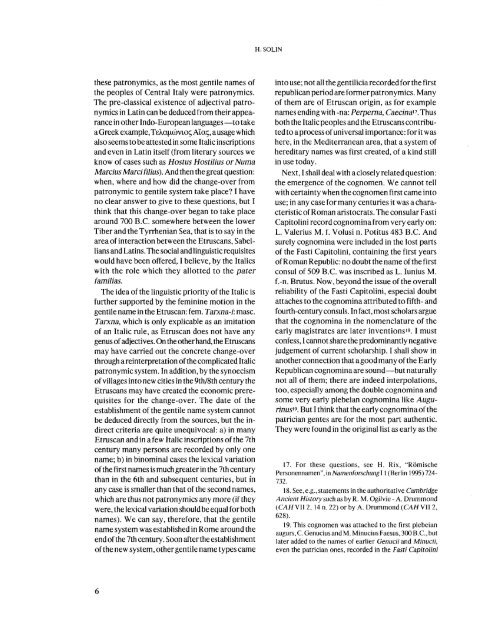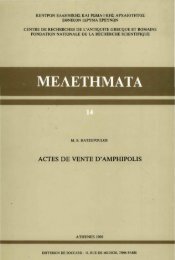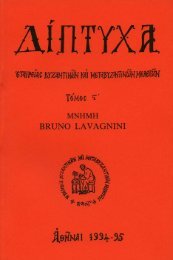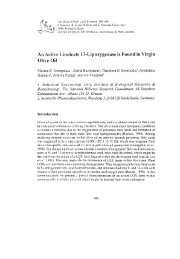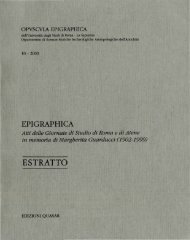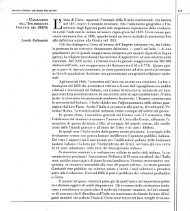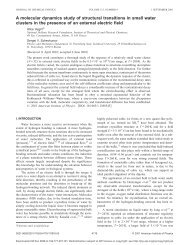Roman onomastics in the Greek East: social and political aspects ...
Roman onomastics in the Greek East: social and political aspects ...
Roman onomastics in the Greek East: social and political aspects ...
You also want an ePaper? Increase the reach of your titles
YUMPU automatically turns print PDFs into web optimized ePapers that Google loves.
<strong>the</strong>se patronymics, as <strong>the</strong> most gentile names of<br />
<strong>the</strong> peoples of Central Italy were patronymics.<br />
The pre-classical existence of adjectival patronymics<br />
<strong>in</strong> Lat<strong>in</strong> can be deduced from <strong>the</strong>ir appearance<br />
<strong>in</strong> o<strong>the</strong>r Indo-European languages —to take<br />
a <strong>Greek</strong> example, Τελαμώνιος Αίας, a usage which<br />
also seems to be attested <strong>in</strong> some Italic <strong>in</strong>scriptions<br />
<strong>and</strong> even <strong>in</strong> Lat<strong>in</strong> itself (from literary sources we<br />
know of cases such as Hostus Hostilius orNuma<br />
Marcius Marcifilius). And <strong>the</strong>n <strong>the</strong> great question :<br />
when, where <strong>and</strong> how did <strong>the</strong> change-over from<br />
patronymic to gentile system take place? I have<br />
no clear answer to give to <strong>the</strong>se questions, but I<br />
th<strong>in</strong>k that this change-over began to take place<br />
around 700 B.C. somewhere between <strong>the</strong> lower<br />
Tiber <strong>and</strong> <strong>the</strong> Tyrrhenian Sea, that is to say <strong>in</strong> <strong>the</strong><br />
area of <strong>in</strong>teraction between <strong>the</strong> Etruscans, Sabellians<br />
<strong>and</strong> Lat<strong>in</strong>s. The <strong>social</strong> <strong>and</strong> l<strong>in</strong>guistic requisites<br />
would have been offered, I believe, by <strong>the</strong> Italics<br />
with <strong>the</strong> role which <strong>the</strong>y allotted to <strong>the</strong> pater<br />
familias.<br />
The idea of <strong>the</strong> l<strong>in</strong>guistic priority of <strong>the</strong> Italic is<br />
fur<strong>the</strong>r supported by <strong>the</strong> fem<strong>in</strong><strong>in</strong>e motion <strong>in</strong> <strong>the</strong><br />
gentile name <strong>in</strong> <strong>the</strong> Etruscan: fern. Tarxna-i: masc.<br />
Tarxna, which is only explicable as an imitation<br />
of an Italic rule, as Etruscan does not have any<br />
genus of adjectives. On <strong>the</strong> o<strong>the</strong>r h<strong>and</strong>, <strong>the</strong> Etruscans<br />
may have carried out <strong>the</strong> concrete change-over<br />
through a re<strong>in</strong>terpretation of <strong>the</strong> complicated Italic<br />
patronymic system. In addition, by <strong>the</strong> synoecism<br />
of villages <strong>in</strong>to new cities <strong>in</strong> <strong>the</strong> 9th/8th century <strong>the</strong><br />
Etruscans may have created <strong>the</strong> economic prerequisites<br />
for <strong>the</strong> change-over. The date of <strong>the</strong><br />
establishment of <strong>the</strong> gentile name system cannot<br />
be deduced directly from <strong>the</strong> sources, but <strong>the</strong> <strong>in</strong>direct<br />
criteria are quite unequivocal: a) <strong>in</strong> many<br />
Etruscan <strong>and</strong> <strong>in</strong> a few Italic <strong>in</strong>scriptions of <strong>the</strong> 7th<br />
century many persons are recorded by only one<br />
name; b) <strong>in</strong> b<strong>in</strong>om<strong>in</strong>al cases <strong>the</strong> lexical variation<br />
of <strong>the</strong> first names is much greater <strong>in</strong> <strong>the</strong> 7th century<br />
than <strong>in</strong> <strong>the</strong> 6th <strong>and</strong> subsequent centuries, but <strong>in</strong><br />
any case is smaller than that of <strong>the</strong> second names,<br />
which are thus not patronymics any more (if <strong>the</strong>y<br />
were, <strong>the</strong> lexical variation should be equal for both<br />
names). We can say, <strong>the</strong>refore, that <strong>the</strong> gentile<br />
name system was established <strong>in</strong> Rome around <strong>the</strong><br />
end of <strong>the</strong> 7th century. Soon after <strong>the</strong> establishment<br />
of <strong>the</strong> new system, o<strong>the</strong>r gentile name types came<br />
6<br />
H. SOLIN<br />
<strong>in</strong>to use; not all <strong>the</strong> gentilicia recorded for <strong>the</strong> first<br />
republican periodare former patronymics. Many<br />
of <strong>the</strong>m are of Etruscan orig<strong>in</strong>, as for example<br />
names end<strong>in</strong>g with -na: Perpetua, Caec<strong>in</strong>a n . Thus<br />
both <strong>the</strong> Italic peoples <strong>and</strong> <strong>the</strong> Etruscans contributed<br />
to aprocess of universal importance: for it was<br />
here, <strong>in</strong> <strong>the</strong> Mediterranean area, that a system of<br />
hereditary names was first created, of a k<strong>in</strong>d still<br />
<strong>in</strong> use today.<br />
Next, I shall deal with a closely related question:<br />
<strong>the</strong> emergence of <strong>the</strong> cognomen. We cannot tell<br />
with certa<strong>in</strong>ty when <strong>the</strong> cognomen first came <strong>in</strong>to<br />
use; <strong>in</strong> any case for many centuries it was a characteristic<br />
of <strong>Roman</strong> aristocrats. The consular Fasti<br />
Capitol<strong>in</strong>i record cognom<strong>in</strong>a from very early on:<br />
L. Valerius M. f. Volusi n. Potitus 483 B.C. And<br />
surely cognom<strong>in</strong>a were <strong>in</strong>cluded <strong>in</strong> <strong>the</strong> lost parts<br />
of <strong>the</strong> Fasti Capitol<strong>in</strong>i, conta<strong>in</strong><strong>in</strong>g <strong>the</strong> first years<br />
of <strong>Roman</strong> Republic: no doubt <strong>the</strong> name of <strong>the</strong> first<br />
consul of 509 B.C. was <strong>in</strong>scribed as L. Iunius M.<br />
f.-n. Brutus. Now, beyond <strong>the</strong> issue of <strong>the</strong> overall<br />
reliability of <strong>the</strong> Fasti Capitol<strong>in</strong>i, especial doubt<br />
attaches to <strong>the</strong> cognom<strong>in</strong>a attributed to fifth- <strong>and</strong><br />
fourth-century consuls. In fact, most scholars argue<br />
that <strong>the</strong> cognom<strong>in</strong>a <strong>in</strong> <strong>the</strong> nomenclature of <strong>the</strong><br />
early magistrates are later <strong>in</strong>ventions 18 .1 must<br />
confess, I cannot share <strong>the</strong> predom<strong>in</strong>antly negative<br />
judgement of current scholarship. I shall show <strong>in</strong><br />
ano<strong>the</strong>r connection that a good many of <strong>the</strong> Early<br />
Republican cognom<strong>in</strong>a are sound—but naturally<br />
not all of <strong>the</strong>m; <strong>the</strong>re are <strong>in</strong>deed <strong>in</strong>terpolations,<br />
too, especially among <strong>the</strong> double cognom<strong>in</strong>a <strong>and</strong><br />
some very early plebeian cognom<strong>in</strong>a like Augur<strong>in</strong>us<br />
i9 . But I th<strong>in</strong>k that <strong>the</strong> early cognom<strong>in</strong>a of <strong>the</strong><br />
patrician gentes are for <strong>the</strong> most part au<strong>the</strong>ntic.<br />
They were found <strong>in</strong> <strong>the</strong> orig<strong>in</strong>al list as early as <strong>the</strong><br />
17. For <strong>the</strong>se questions, see H. Rix, "Römische<br />
Personennamen", <strong>in</strong> Namenforschungl 1 (Berl<strong>in</strong> 1995)724<br />
732.<br />
18. See, e.g., statements <strong>in</strong> <strong>the</strong> authoritative Cambridge<br />
Ancient History such as by R. M. Ogilvie - A. Drummond<br />
(CAH VII 2, 14 η. 22) or by A. Drummond (CAH VII 2,<br />
628).<br />
19. This cognomen was attached to <strong>the</strong> first plebeian<br />
augurs, C. Genucius <strong>and</strong> M. M<strong>in</strong>ucius Faesus, 300 B.C., but<br />
later added to <strong>the</strong> names of earlier Genucii <strong>and</strong> M<strong>in</strong>ucii,<br />
even <strong>the</strong> patrician ones, recorded <strong>in</strong> <strong>the</strong> Fasti Capitol<strong>in</strong>i


